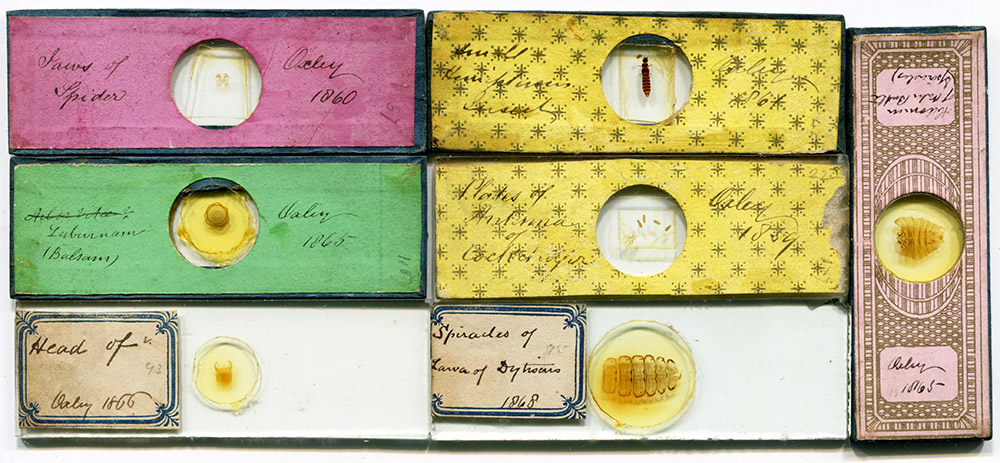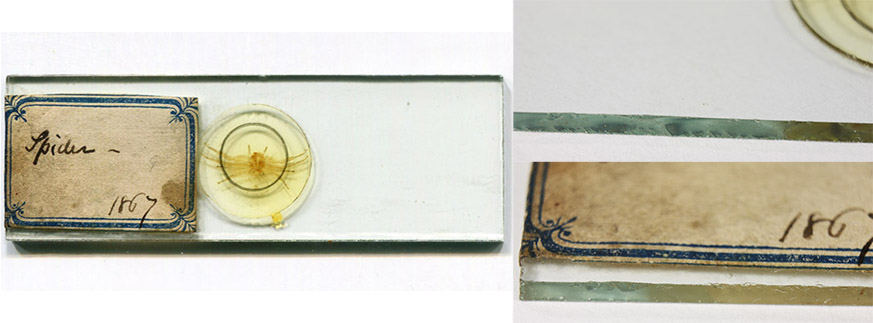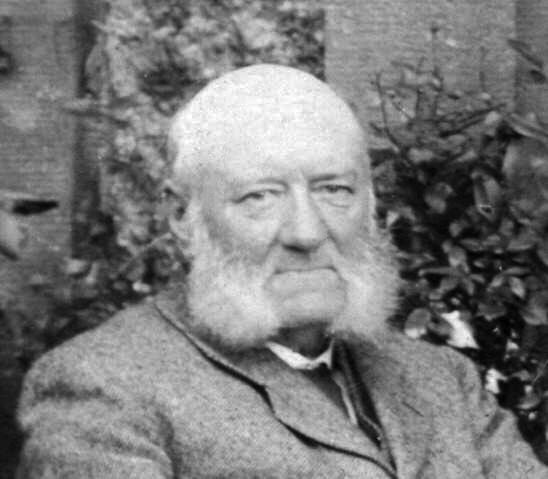Frederick Oxley, 1838 - 1919
by Brian Stevenson
Last updated January, 2021
The mid-1800s saw a tremendous increase in scientific recreation in England and many other countries. Many people were drawn to microscopy, and microscope clubs sprung up throughout the British Isles. Numerous amateurs produced great quantities of microscope slides, but large proportion of those were not marked by their maker, and their histories have been lost to time.
Yet, a few early microscopists, such as Frederick Oxley, signed their slides and thereby allow us to connect those artifacts with the circumstances of their production. A couple of dozen of Oxley's slides recently came to light, which are signed and dated from the late 1850s through the late 1860s (Figures 1-3). Close examination reveals details of slide-making techniques of the time.
Oxley was not an ordinary amateur microscopist. He was both a Fellow of the Royal Microscopical Society and a member of the Quekett Microscopical Club. He served for many years as an officer of the QMC.
Without a doubt, Oxley made a lot of microscope slides throughout his life. It is not known whether he signed others, but the illustrated 1850s-60s slides may help to identify his handwriting.

Figure 1.
Microscope slides that were produced by Frederick Oxley between 1859 and 1868. Several styles of slide-preparation are evident. All of the slides were cut from larger sheets of glass, and are somewhat irregular in size and shape, and most do not have smooth edges. The cover slips of three slides are irregularly-cut, presumably broken by Oxley from larger sheets, while the other four slides used what appear to be commercially-prepared circular coverslips. The slides with pink or green plain cover papers, and the upper slide with stars-on-yellow cover paper, were all finished by first gluing a strip of dark blue paper around the edges, and folded over onto the front and back, then cover papers were glued onto the front and back. The lower slide with stars-on-yellow cover paper, dated 1859, was made without edging paper, and simply has cover papers glued onto the front and back. The slide on the right end, dated 1865, was made with edging papers and a common, commercially-available patterned cover paper, which could be purchased at optical and other shops. The stars-on-yellow design (and variants thereof) are frequently seen on microscope slides of this era, so they might also have been purchased from microscope supply shops. The bottom two slides, dated 1866 and 1868, were prepared without cover papers. Figures 2 and 3 illustrate some details of Oxley’s construction techniques.

Figure 2.
Details of an unpapered Oxley microscope slide, dated 1867. As with all of his slides in this group, the glass slip was cut from a larger sheet and, in most cases, he left the edges rough and sharp (see details on the right). The primary function of the edging paper seen on most of Oxley’s slides, and the majority of slides of the mid-1800s, was to cover over the sharp glass edges. The circular cover slip was probably purchased from a supply shop – the purpose of the interior circle is not obvious. The reason why some of Oxley’s slides are papered while others have only crudely-cut glass is not certain, but, noting that most of his unpapered slides are not signed, while his papered ones are, it is possible that the papered slides were fancied-up for exhibition to colleagues (and signed to avoid loss), while the others were for his use at home only.

Figure 3.
Details of a paper-covered microscope slide from Frederick Oxley, dated 1861. At the far left, folds of the edging paper are visible underneath the cover paper. Oxley’s edging papers were approximately 0.5 inch / 1.3 cm in width. Oxley did not completely paper this slide, probably because the insect specimen is so large. As with all of these Oxley slides, the slide glass was cut from a larger sheet. For this one, however, he filed the sharp edges from the exposed glass (right image), suggesting that he prettied it up for exhibition.

Figure 4.
Undated photograph of Frederick Oxley. Adapted for nonprofit, educational purposes from https://www.ancestry.com/family-tree/person/tree/13830365/person/-1433139/facts.
Frederick Oxley was born on August 19, 1838, in Liverpool, son of Frederick and Martha Oxley. The father worked as a "bookkeeper". The family was relatively well-off, with the 1841 census showing them as having two domestic servants.
Our Frederick trained as a solicitor, and moved to London ca. 1861. That year's census recorded that Oxley was boarding in Holborn, Middlesex. On October 8, 1864, he married Jane Linton at Saint Stephen's, Lambeth. His address at the time was 17 Leigh Villas, Saint Pancras. The couple had 8 children. The first, Edith, bas born in 1865 but died the following year. The other seven children all lived into adulthood. The eldest surviving child, Frederick John, who was born in 1866, became a surgeon and joined the Quekett Microscopical Club in 1903.
Oxley joined the QMC on December 27, 1867. The slides shown above in Figures 1-3 indicate that Oxley had a strong interest in microscopy for several years prior to joining the QMC. Considering the price of dues, it makes sense that he would work alone, then with a few friends, before joining a formal microscopical society.
Minutes of QMC meetings indicate that Oxley frequently exhibited slides to colleagues, such as the "various entomological preparations" that he showed on October 13, 1871. By the following year, Oxley had been elected to the QMC Committee. In 1880, he was a member of the Excursion Committee.
Through the end of the century, QMC membership rolls listed Oxley's contact information as his law office address, 8 Crosby Square, Bishopsgate, London. From at least 1871 through the end of that decade, he lived at Grove Hill, in Woodford, Essex.
Oxley's home in the country helped both his own and his colleagues' microscopical studies. For example, Henry Davis thanked Oxley in his 1876 paper on Volvox, stating that "by the assistance of my friend, Mr. F. Oxley (who is the best collector I know), a fairly continuous supply has been kept up, mainly from the ponds about Snaresbrook". An 1879 paper on rotifers by C.T. Hudson noted that a "remarkable new species was discovered by Mr. F. Oxley last June in a pond at Snaresbrook. Mr. Oxley was so kind as to send me several specimens".
Frederick Oxley was elected as a Fellow of the Royal Microscopical Society in 1879.
His wife, Jane, died in October, 1881. Oxley later wrote that during the spring of 1882 he was "out of health". Noting that Oxley ceased membership on QMC committees at that time, it is likely that ill-health and family demands curtailed some of his extracurricular activities.
Frederick remarried on October 20, 1883, to Rachel Blackburn Bates, a widow of his same age. Rachel also had children from her previous marriage, although both were then in their late teens. On the other hand, Frederick had six children at home, between 6 and 15 (the eldest boarded away at school), so Rachel's assistance would have been sorely needed.
Oxley appears to be back to normal soon afterward. On June 11, 1884, he read a paper to the Royal Microscopical Society on a new poriferan that he had found near his Essex home. On Protospongia pedicellate, he wrote, "This interesting organism was first discovered by me in a pond near Snaresbrook, Essex, in the spring of the year 1882. I was searching the numerous ponds in that neighbourhood for Volvox globator, and happened to dip a bottle amongst some rushes in a quiet corner, which appeared to be a likely place to find what I was looking for. On holding the bottle up to the light I observed in it a number of minute flocculent bodies, the nature of which I could not determine with a pocket-lens, and therefore carried them home for further examination. … Being out of health, and, moreover, having only a very slight acquaintance with the group of Choano-flagellata, derived from Mr. Saville Kent's papers in the Popular Science Review' and 'Monthly Microscopical Journal', and from some specimens shown me by my friend Mr. Charles Thomas, of Buckhurst Hill, I did not at that time recognize that any new discovery had been made, but I gave some specimens to Mr. Thomas which we examined together, and also spoke of them to another microscopical friend, Mr. C. Livingston, who resides near the pond out of which they had been obtained. … In the spring of the present year, 1884, I again visited the pond in company with Mr. Livingston and Mr. Thomas, and there found the organism again in great abundance".
The relationship between Frederick and Rachel appears to have deteriorated during the 1890s, and they evidently separated. The 1901 census listed Frederick as living with his eldest son and a daughter at 1 Dock Street, Whitechapel. Rachel lived in Bungay, Suffolk, and declared herself to be "single" to the census taker.
Frederick remained with his son until around 1910. The 1911 list of QMC members gave his address as "c/o A.E. Linton, Esq., Box 9. P.O. Nairobi, British East Africa". Linton would have been a relative of his first wife, Jane Linton. Oxley continued his RMS and QMC memberships throughout the remainder of his life.
Frederick Oxley died in Nairobi on March 25, 1919.
Resources
Davis, Henry (1876) On the rotifer Conochilus volvox, Monthly Microscopical Journal, pages 1-5
England census and other records, accessed through ancestry.com
Family tree of Frederick Oxley (accessed January, 2021) https://www.ancestry.com/family-tree/person/tree/13830365/person/-1433139/facts
Hudson, C.T. (1879) On Oecistes umbella and other rotifers, Journal of the Royal Microscopical Society, Vol. 2, pages 1-8
Journal of the Quekett Microscopical Club (1871) Minutes from the meeting of October 13, Vol. 2, page 281
Journal of the Quekett Microscopical Club (1871) Officers and Committee Members, and List of Members
Journal of the Quekett Microscopical Club (1875) Officers and Committee Members, and List of Members
Journal of the Quekett Microscopical Club (1878) Officers and Committee Members, and List of Members
Journal of the Quekett Microscopical Club (1880) Officers and Committee Members, and List of Members
Journal of the Quekett Microscopical Club (1882) Officers and Committee Members, and List of Members
Journal of the Quekett Microscopical Club (1891) List of Members
Journal of the Quekett Microscopical Club (1901) List of Members
Journal of the Quekett Microscopical Club (1904) List of Members
Journal of the Quekett Microscopical Club (1908) List of Members
Journal of the Quekett Microscopical Club (1911) List of Members
Journal of the Quekett Microscopical Club (1918) List of Members
Journal of the Royal Microscopical Society (1879) Fellows, Volume 2
London Gazette (1878) "Fredk. Oxley, 8 Crosby-square, London, EC, Solicitor for and on behalf of the said Executor", page 2241
Oxley, Frederick (1884) On Protospongia pedicellata, a new compound infusorian, Journal of the Royal Microscopical Society, pages 530-532
Quarterly Journal of Science (1872) Microscopy, Vol. 9, page 270
Register of Frederick Oxley's death (1919) accessed through ancestry.com



